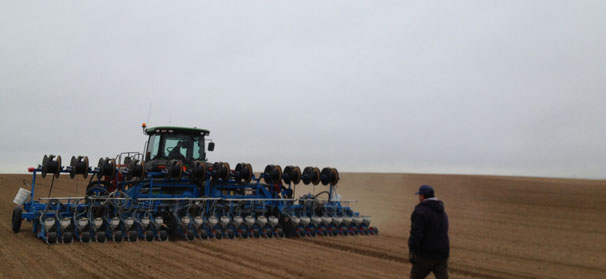

May 21, 2012Idaho grower builds 48-row onion planter
Bigger is better – at least when it comes to planting onions and drip irrigation. That’s what Russell Frisby has determined since he started growing onions in western Idaho’s Treasure Valley.
When Frisby, manager of Frisby Farms in Sand Hollow, Idaho, decided to diversify his crop portfolio and include yellow onions three years ago, he had no idea it would lead to designing one of the largest onion planters in the world.
For more than 30 years, Frisby Farms has grown Russet Burbank potatoes, as well as sugar beets, alfalfa, corn and grain. Currently, he farms about 2,300 acres annually, 300 of them in onions.
When he decided to grow onions, he also made the decision to go with a drip irrigation system as the crop’s sole water source. His reasons for going with a drip system were threefold.
“Our ground is pretty steep,” Frisby said. “Some of our hills have 70 feet of fall in them. I mean big hills. We can just segment and isolate the hills and drip it.”
The second reason is the efficiency in the field. He’s able to cut down on his water consumption while reducing the amount of fertilizer inputs.
The third reason is related to marketing.
“The onion doesn’t like overhead (irrigation) in our area,” he said. “Sheds won’t buy an onion under sprinkler in our area, so you have to do drip.”
Frisby acknowledged that there is a downside to drip.
“It’s pretty labor-intensive getting it in and out, because we’re on an all-temporary drip,” he said.
Last year, in an effort to cut some of his labor costs and accelerate planting time, Frisby had a new planter custom built for his operation. He said he came up with the concept after his first season of growing onions.
“It seemed we could be more efficient changing the bed systems to push the population and get more out of the ground,” said Frisby, detailing his reasons for building the giant planter. “We looked at an 88-inch bed, but it’s too small to get everything in. We stretched our equipment to an 11-foot bed.”
The planter is an amalgamation of three 11-foot-wide units fastened together. At 33 feet in width, the planter, built by Monosem, will plant 48 lines of onion seed while laying drip tape and starter fertilizer between the rows – all this while averaging 5 to 6 acres per hour. Frisby said the planter lays down four tapes of drip in each 11-foot bed.
“We wanted the onion to get the same amount of water and fertilizer across the bed,” Frisby said. “By widening the bed to 132 inches, everything is evenly distributed.”
Frisby also cited the speed and efficiency of the planter as important features.
“When you plant the onions, you have a narrow window when it warms up before the rainy season sets in,” he said. “We can plant 60 to 70 acres on a good day, without too much wind and wet conditions.”
He said it takes two to three people to run the planter. While he spent $150,000 to construct it, he hopes to recoup his investment in labor and fuel savings, as well as the efficiencies found in the greater scale of production afforded by the huge planter.
“We’re growing 33 percent more onions than on a conventional drip system,” Frisby said.
One problem with the drip system Frisby did not foresee was varmints.
“If you have bad rodents, like gophers and stuff, they seem to search out the emitter and really want to chew it up,” he said.
They used drip irrigation in an old hay field that was planted in spuds last year, and the rodents “just annihilated” the emitters, he said.
“As soon as it was laid out, (there’s) something they sense in it and they just go right through it and start chewing down on it,” Frisby said.
Asked if the investment in the planter was justified in this down year for onion prices, Frisby laughed.
“I don’t know,” he said. “I hope it will pay, eventually. American producers are too efficient.”
His new planter has attracted the attention of other growers, however. According to Frisby, two growers in the area are building similar machines.
By Bill Schaefer, Contributing Editor














